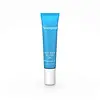What's inside
What's inside
 Key Ingredients
Key Ingredients

 Benefits
Benefits

 Concerns
Concerns

 Ingredients Side-by-side
Ingredients Side-by-side

Water
Skin ConditioningDimethicone
EmollientGlycerin
HumectantSilica
AbrasiveAcrylamide/Sodium Acryloyldimethyltaurate Copolymer
Emulsion StabilisingPrunus Armeniaca Kernel Oil
MaskingIsohexadecane
EmollientDimethicone/Vinyl Dimethicone Crosspolymer
Skin ConditioningHydroxypropyl Tetrahydropyrantriol
Skin ConditioningPropylene Glycol
HumectantCI 77891
Cosmetic ColorantPhenoxyethanol
PreservativeAcrylates/C10-30 Alkyl Acrylate Crosspolymer
Emulsion StabilisingChlorphenesin
AntimicrobialMica
Cosmetic ColorantTriethanolamine
BufferingPolysorbate 80
EmulsifyingCaffeine
Skin ConditioningAscorbyl Glucoside
AntioxidantDimethiconol
EmollientAdenosine
Skin ConditioningTocopherol
AntioxidantHydrolyzed Hyaluronic Acid
HumectantHydroxyethylpiperazine Ethane Sulfonic Acid
BufferingDisodium EDTA
Sorbitan Oleate
EmulsifyingTin Oxide
AbrasiveWater, Dimethicone, Glycerin, Silica, Acrylamide/Sodium Acryloyldimethyltaurate Copolymer, Prunus Armeniaca Kernel Oil, Isohexadecane, Dimethicone/Vinyl Dimethicone Crosspolymer, Hydroxypropyl Tetrahydropyrantriol, Propylene Glycol, CI 77891, Phenoxyethanol, Acrylates/C10-30 Alkyl Acrylate Crosspolymer, Chlorphenesin, Mica, Triethanolamine, Polysorbate 80, Caffeine, Ascorbyl Glucoside, Dimethiconol, Adenosine, Tocopherol, Hydrolyzed Hyaluronic Acid, Hydroxyethylpiperazine Ethane Sulfonic Acid, Disodium EDTA, Sorbitan Oleate, Tin Oxide
Water
Skin ConditioningDimethicone
EmollientGlycerin
HumectantCetearyl Olivate
Sorbitan Olivate
EmulsifyingPolyacrylamide
Phenoxyethanol
PreservativeDimethicone/Vinyl Dimethicone Crosspolymer
Skin ConditioningSynthetic Beeswax
Emulsion StabilisingC13-14 Isoparaffin
EmollientDimethicone Crosspolymer
Emulsion StabilisingCarbomer
Emulsion StabilisingTrehalose
HumectantDimethiconol
EmollientChlorphenesin
AntimicrobialLaureth-7
EmulsifyingSodium Hyaluronate
HumectantEthylhexylglycerin
Skin ConditioningSodium Hydroxide
BufferingC12-14 Pareth-12
EmulsifyingWater, Dimethicone, Glycerin, Cetearyl Olivate, Sorbitan Olivate, Polyacrylamide, Phenoxyethanol, Dimethicone/Vinyl Dimethicone Crosspolymer, Synthetic Beeswax, C13-14 Isoparaffin, Dimethicone Crosspolymer, Carbomer, Trehalose, Dimethiconol, Chlorphenesin, Laureth-7, Sodium Hyaluronate, Ethylhexylglycerin, Sodium Hydroxide, C12-14 Pareth-12
 Reviews
Reviews

Ingredients Explained
These ingredients are found in both products.
Ingredients higher up in an ingredient list are typically present in a larger amount.
Chlorphenesin is a synthetic preservative. It helps protect a product against bacteria in order to extend shelf life. In most cases, Chlorphenesin is paired with other preservatives such as phenoxyethanol and caprylyl glycol.
Chlorphenesin is a biocide. This means it is able to help fight the microorganisms on our skin. It is also able to fight odor-releasing bacteria.
Chlorphenesin is soluble in both water and glycerin.
Studies show Chlorphenesin is easily absorbed by our skin. You should speak with a skincare professional if you have concerns about using Chlorphenesin.
Learn more about ChlorphenesinDimethicone is a type of synthetic silicone created from natural materials such as quartz.
What it does:
Dimethicone comes in different viscosities:
Depending on the viscosity, dimethicone has different properties.
Ingredients lists don't always show which type is used, so we recommend reaching out to the brand if you have questions about the viscosity.
This ingredient is unlikely to cause irritation because it does not get absorbed into skin. However, people with silicone allergies should be careful about using this ingredient.
Note: Dimethicone may contribute to pilling. This is because it is not oil or water soluble, so pilling may occur when layered with products. When mixed with heavy oils in a formula, the outcome is also quite greasy.
Learn more about DimethiconeThis ingredient is a silicone used to improve the texture of products and absorb oil. It does not get absorbed into the skin.
Like other silicones, Dimethicone/Vinyl Dimethicone Crosspolymer helps condition the skin by creating a barrier. In this sense, it can act as an emollient and trap moisture in.
This ingredient is a type of elastomer.
Learn more about Dimethicone/Vinyl Dimethicone CrosspolymerDimethiconol is a silicone that resembles the popular dimethicone. Like other silicones, it is an emollient. Emollients create a thin film on skin to prevent moisture from escaping.
This ingredient helps to create a silky texture and improve spreadability. Due to its high molecular weight and thickness, it is often combined with cyclopentasiloxane.
Glycerin is already naturally found in your skin. It helps moisturize and protect your skin.
A study from 2016 found glycerin to be more effective as a humectant than AHAs and hyaluronic acid.
As a humectant, it helps the skin stay hydrated by pulling moisture to your skin. The low molecular weight of glycerin allows it to pull moisture into the deeper layers of your skin.
Hydrated skin improves your skin barrier; Your skin barrier helps protect against irritants and bacteria.
Glycerin has also been found to have antimicrobial and antiviral properties. Due to these properties, glycerin is often used in wound and burn treatments.
In cosmetics, glycerin is usually derived from plants such as soybean or palm. However, it can also be sourced from animals, such as tallow or animal fat.
This ingredient is organic, colorless, odorless, and non-toxic.
Glycerin is the name for this ingredient in American English. British English uses Glycerol/Glycerine.
Learn more about GlycerinPhenoxyethanol is a preservative that has germicide, antimicrobial, and aromatic properties. Studies show that phenoxyethanol can prevent microbial growth. By itself, it has a scent that is similar to that of a rose.
It's often used in formulations along with Caprylyl Glycol to preserve the shelf life of products.
Water. It's the most common cosmetic ingredient of all. You'll usually see it at the top of ingredient lists, meaning that it makes up the largest part of the product.
So why is it so popular? Water most often acts as a solvent - this means that it helps dissolve other ingredients into the formulation.
You'll also recognize water as that liquid we all need to stay alive. If you see this, drink a glass of water. Stay hydrated!
Learn more about Water